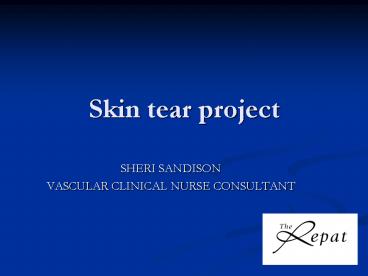Skin tear project - PowerPoint PPT Presentation
1 / 28
Title:
Skin tear project
Description:
A skin tear is: ...a traumatic wound occurring principally on ... Promote shoes that are well fitted and refer to Podiatry if required. Preventative Measures: ... – PowerPoint PPT presentation
Number of Views:1605
Avg rating:3.0/5.0
Title: Skin tear project
1
Skin tear project
- SHERI SANDISON
- VASCULAR CLINICAL NURSE CONSULTANT
2
Project
- Literature search
- Audit current practice
- Develop implement guidelines
- Publish
- Re-audit
- Ongoing education program
3
Project team
- Barb Hutchinson
- Deb Muir
- Beth McErlean
- Sheri Sandison
- Wendy Humphreys
- Wound Management Committee
4
A skin tear is
- a traumatic wound occurring principally on the
extremities of older adults, as a result of
friction alone or shearing and friction forces
which separate the epidermis from the dermis or
which separate both the epidermis and the dermis
from underlying structures. - Payne-Martin, 1993
5
Literature Search
- Payne-Martin Classification system
- facilitate clinical judgement
- provide opportunity to evaluate the effectiveness
of selected treatments, - provide consistency of documentation and
communication - provide a mechanism for estimating the healing
time and costs associated with care.
6
Payne-Martin Classification Category 1
7
Category 2 (A B)
8
Category 3
9
Literature Search
- Limited acute setting prevalence data
- No optimal treatment but treatment aims to
- Stop bleeding
- Prevent infection
- Recover skin integrity
- Promote healing
- Minimise pain /promote comfort
- Varied healing rates costs
10
Audit
- Number of skin tears
- Classification
- Location
- Cause
- Wound management practice
- Documentation
11
Results
- 10.7 (3.8 orthopaedic to 27 palliative care)
- Majority class 2A (lt25 epidermal loss)
- 25 from fall
- 63 upper body 36 lower body
- Varying dressing choices 24 no dressing
- Scant documentation
12
Guidelines
- Preventative measure
- Immediate action
- Assessment / classification
- Dressing choice
- Discharge
- Documentation
13
(No Transcript)
14
Preventative Measures
- Protect the Skin
- Use emollients, low pH soaps and moisturisers
- Protect lower limb
- Ensure equipment with any sharp edges is padded
- Apply adhesive tapes without tension and with
caution - Remove tapes with caution slowly peel away from
anchored skin consider use of adhesive removing
wipes - Promote shoes that are well fitted and refer to
Podiatry if required.
15
Preventative Measures
- Move without Damage
- Use palms of hands to move patient, avoid pulling
the skin - Use Slippery Sam or lifting device
- Promote clutter free environment
- Provide good lighting (e.g. night lights)
- Use care when bathing, dressing, transferring
transporting at risk patients
16
Immediate Action
- Gently cleanse the skin tear site, removing any
debris - Gently return skin back into position using
moistened cotton buds - Debride non-viable tissue
17
Dressing choice
- The Challenge is to consider
- Varied nursing skill level knowledge
- Properties of the dressing product
- (e.g. absorbency, ease of application removal)
- Product availability cost
- Discharge destination
18
Product Guidelines
- No single product appropriate for all skin tears.
- Match the dressing choice with the skin tear
category - Promote healing
- Reduce trauma
- Manage exudate
- Protect flap
- Protect peri-wound
19
Category 1
- Steri-strip approximated skin in position without
tension. - Cover with low adherent gauze dressing,
melolin, tubifast or crepe bandage. - Change secondary dressing (melolin) prn.
- Complete dressing change on Day 3.
- Leave steri-strips insitu until they curl lift
off
20
Category 2
- Cover with hydrofibre dressing thin
Hydrocolloid - Change according to degree of exudate i.e.
evidence of leakage or hydrocolloid bubbling. - Low exudate thin hydrocolloid
- Moderate / high exudate Hydrofibre thin
hydrocolloid
21
Category 3
- Cover with hydrofibre and thin Hydrocolloid
- Change according to degree of exudate i.e.
evidence of leakage or hydrocolloid bubbling. - Low exudate thin hydrocolloid
- Moderate / high exudate Hydrofibre thin
hydrocolloid
22
On Discharge
- Ensure patient education is provided re wound
care and prevention strategies (brochure) - Ensure community nursing is arranged including
ongoing management plan and dressing supplies
23
Documentation
- Cause
- Site
- Classification
- Dressing type
- Progress
- Note specific interventions on bedside folder
front sheet - Commence wound management chart
- Activate Excelcare wound management UOC
- Complete AIMS incident report
24
Implementation / education program
- Poster
- Wound management folder
- Education
- Ward in-service talks
- Ward wound resource nurses promote
- Wound management course
- Graduate nurse study days
- Ward orientation
- Audit data analysis action plans
25
Re-evaluate / audit
26
(No Transcript)
27
August 2005 Audit results
- Location upper and lower extremities
- Dressing choices improved compliance to
guidelines. - Numbers too small for statistical significance.
- Need ongoing education
- 3 x year auditing
28
Lessons learnt
- A problem with aging population
- Guidelines are valuable
- Specific to your location
- Ongoing education for prevention management
- Evaluation / audit































